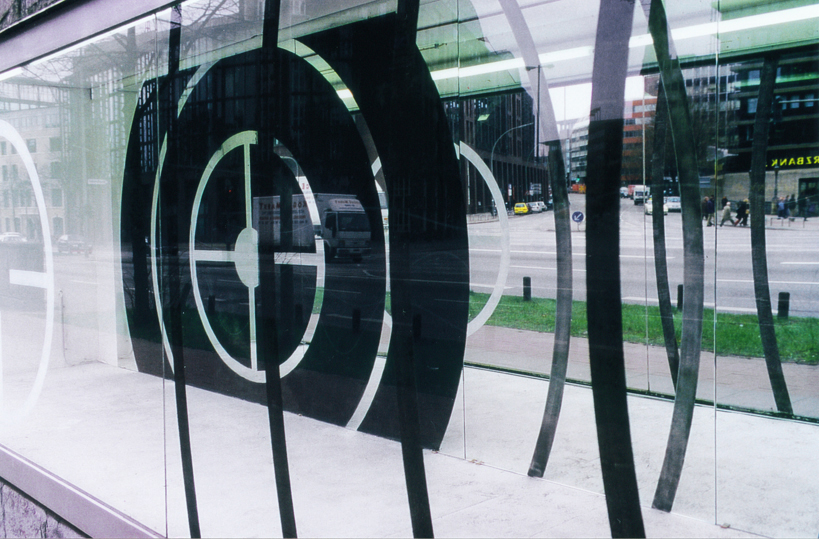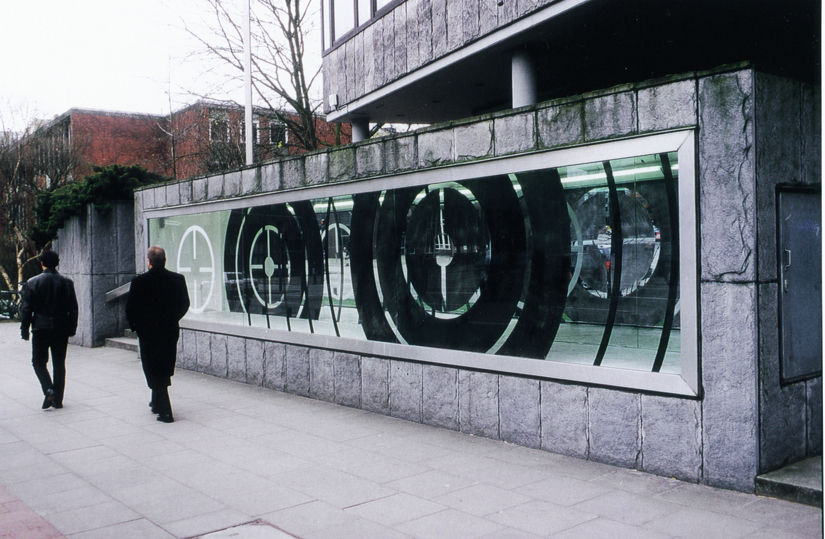

SIGHTED, http://www.zeitbewegungen.de/zeitbewegungen 2003.html, installation, Ost West Straße Hamburg, sponsored by Spiegel (Magazin Publisher), 2003; photos: Joachim Jürs; Glass showcase 10 x 1,80 x 1m, 10 mirrors, colour
In SIGHTED Hamann fixes the silent moment when the object of attention and the reticle are congruent. The two painted situations bring into focus at eye level cars which have to stop at the red light or business people who hurry past. When the spectator looks into the installation he/ she is only looking at his/ her own image. The various reflections of the verre eglomise paintings ('behind-glass' paintings) and the mirror paintings make it unclear on which side a person is standing, who the observer is (reticle) and who the observed (target), or whether there is a third person behind the mirror wall. The basic structure of black and white is fractured by the various reflections which differ depending on the angle of vision of the spectators, and during the movement and journey it becomes a fragmented movie in which the spectator assumes the central part.
SIGHTED, http://www.zeitbewegungen.de/zeitbewegungen 2003.html, Spiegelverlag, Hamburg, 2003; photos: Joachim Jürs; Glasvitrine 10 x 1,80 x 1m, 10 m Spiegelwand, Farbe
In SIGHTED fixiert Hamann räumlich den lautlosen Moment, wenn Zielobjekt (Scheibe) und Fadenkreuz des Suchers deckungsgleich sind. Die zwei Situationen fokussieren jeweils auf Kopfhöhe die an der Ampel haltenden Autofahrer und vorbeieilenden Geschäftsleute. Schaut der Beobachter in die Installation, ist er nur mit seinem eigenen Bild konfrontiert. Das reflektierende Spiel der Hinterglas- und Spiegelmalerei lässt offen, auf welcher Seite man steht, wer Beobachtender (Fadenkreuz) oder Beobachteter (Zielscheibe) ist oder ob es einen Dritten hinter der Spiegelwand gibt.
Die schwarz/weiße Grundstruktur wird durch ihre aus jedem Blickwinkel verschieden wirkende Spiegelung gebrochen und setzt sich während der Bewegung und Fahrt zu einem fragmentarischen Film zusammen, in dem der Betrachter die Hauptrolle übernimmt.
Die schwarz/weiße Grundstruktur wird durch ihre aus jedem Blickwinkel verschieden wirkende Spiegelung gebrochen und setzt sich während der Bewegung und Fahrt zu einem fragmentarischen Film zusammen, in dem der Betrachter die Hauptrolle übernimmt.